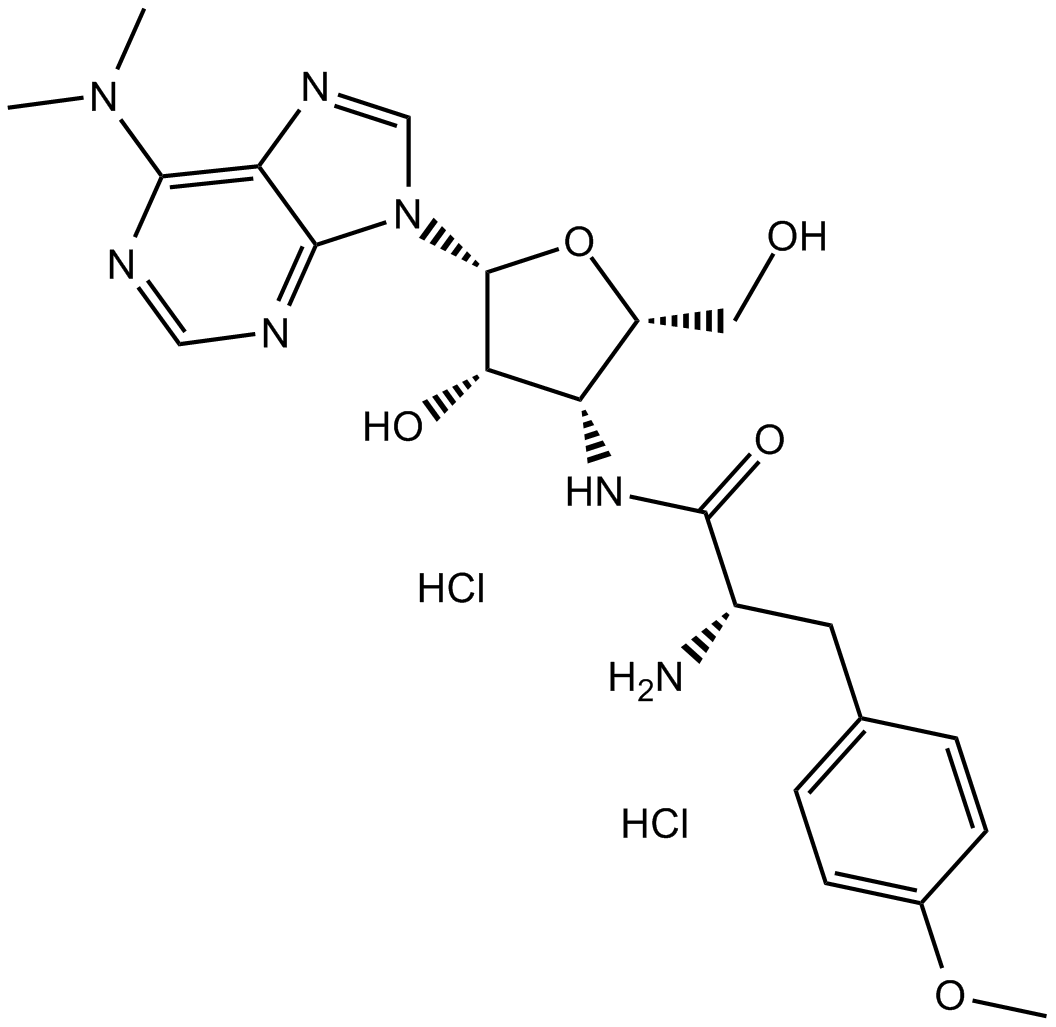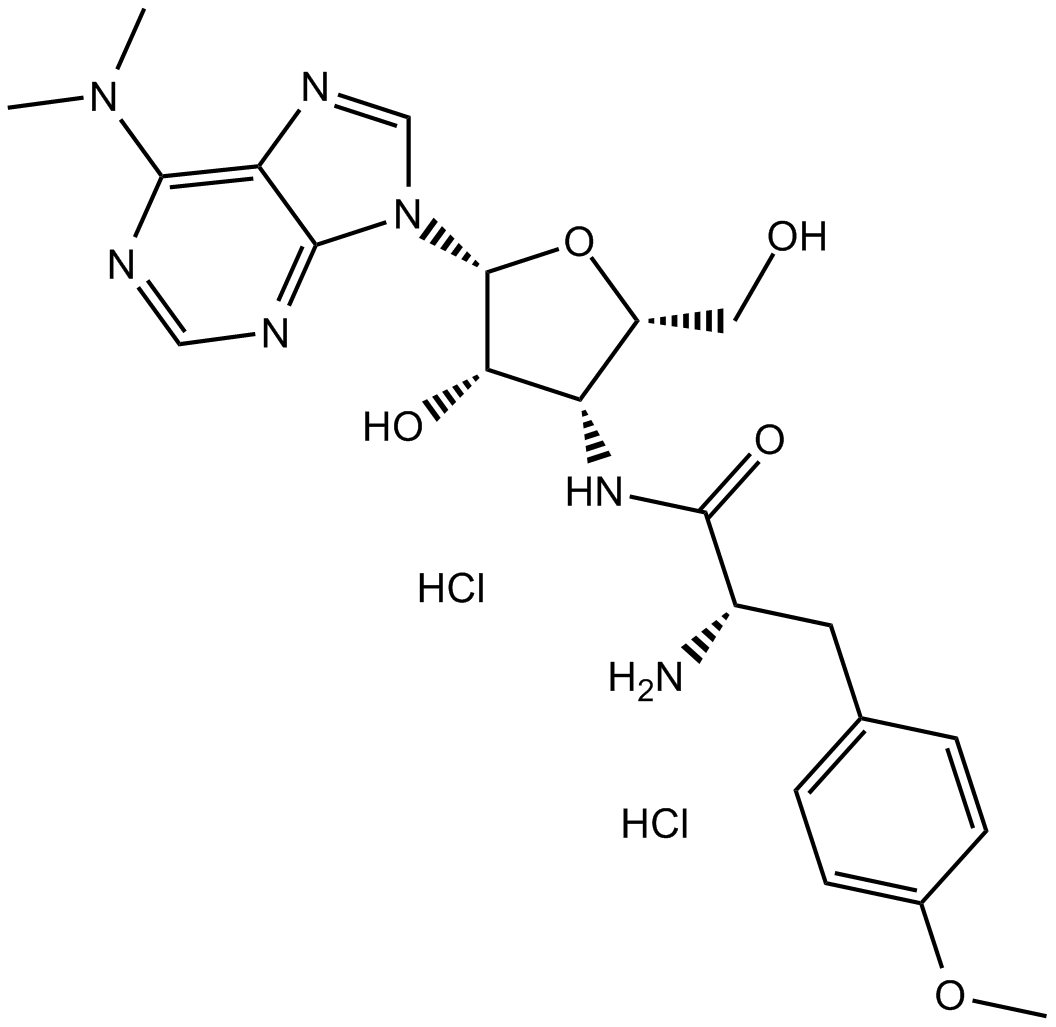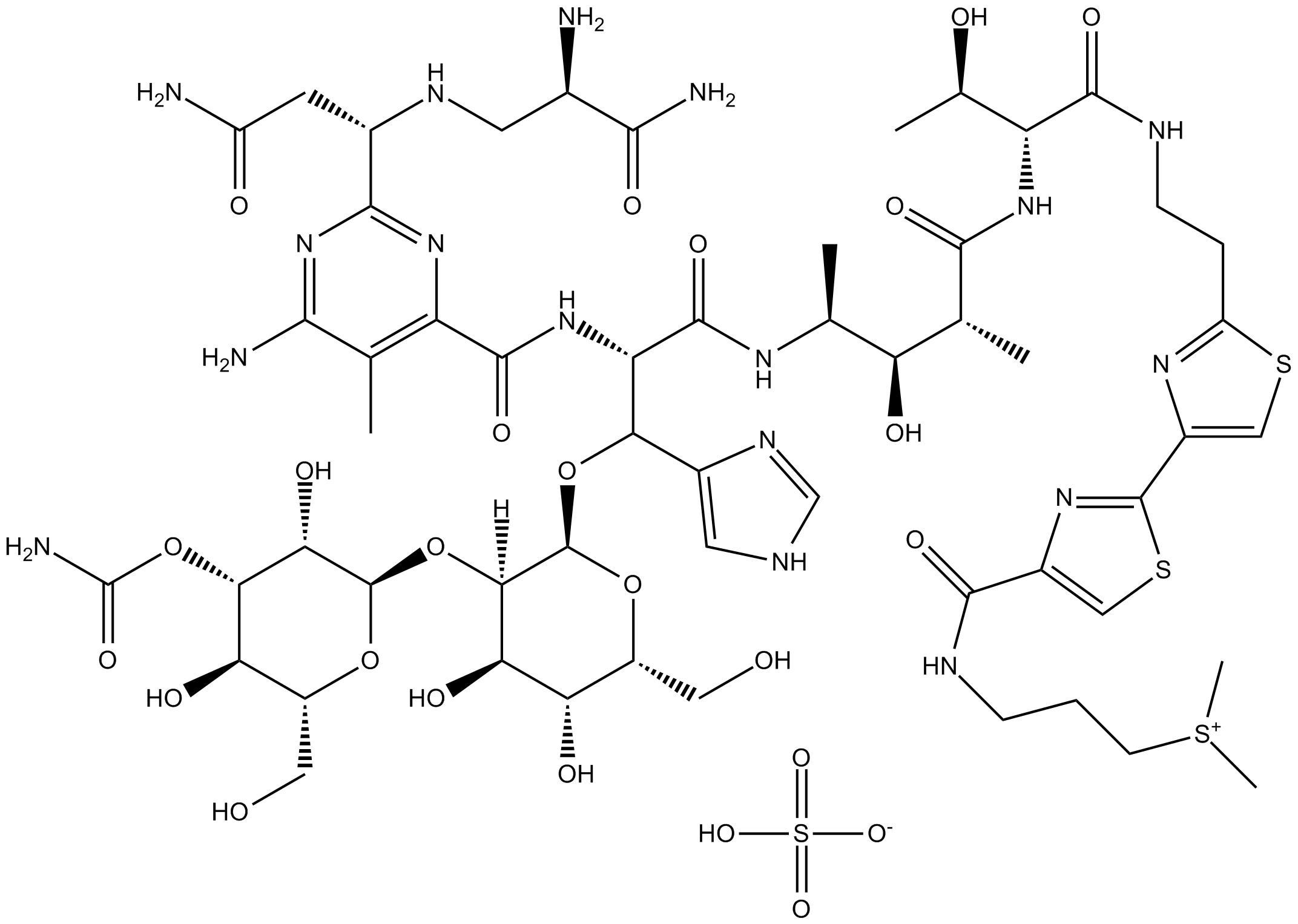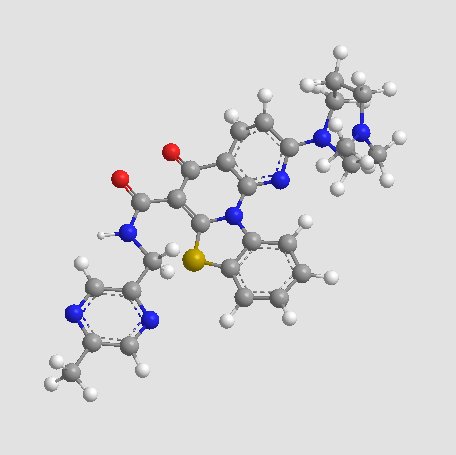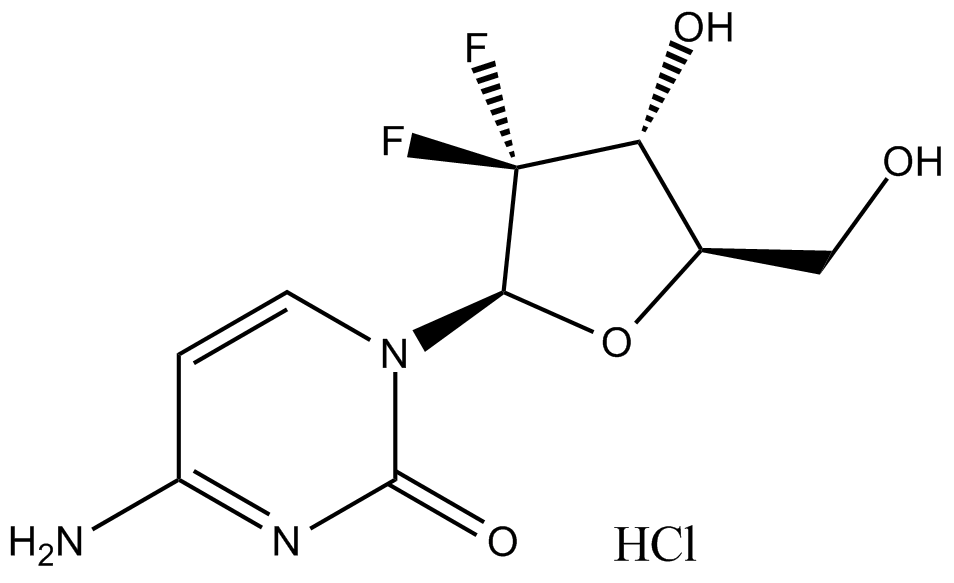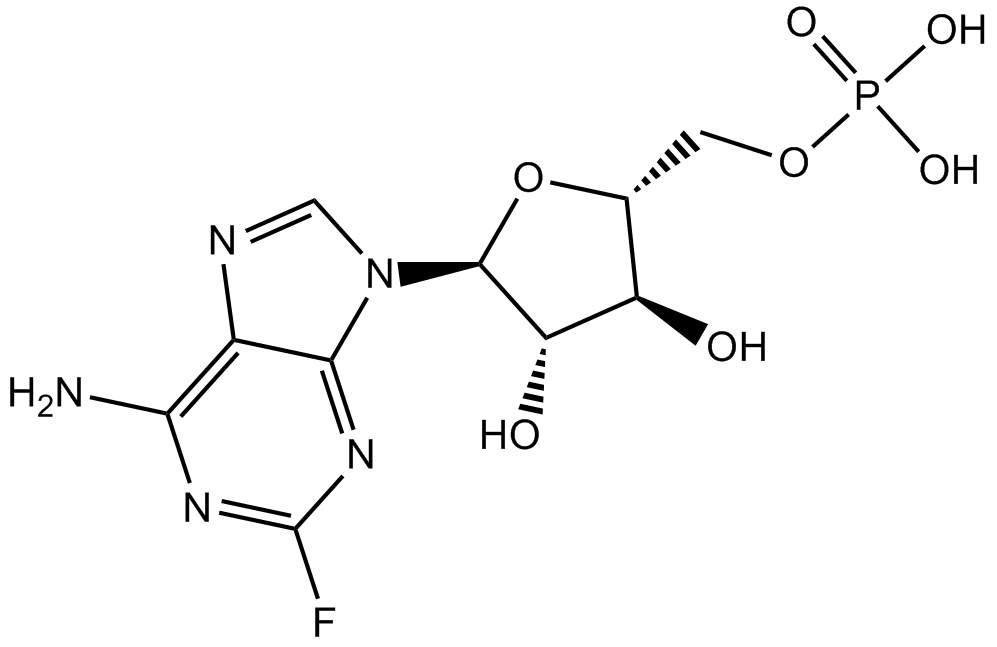Puromycin dihydrochloride
Puromycin dihydrochloride is an aminonucleoside antibiotic functioning as a structural analog of aminoacyl-tRNA. It inhibits protein synthesis by binding competitively to the ribosomal A site, resulting in premature termination of elongating polypeptide chains. This compound is commonly employed in molecular biology for selection and maintenance of stable eukaryotic and prokaryotic cell lines expressing the pac gene encoding puromycin N-acetyltransferase. In mammalian cells, typical inhibitory concentrations (IC50) range from approximately 0.5 to 10 μg/ml, depending on cell type and sensitivity. Puromycin is also utilized in studying translational processes, cellular growth dynamics, and ribosome function across diverse organisms and experimental conditions.
- 1. Wang Jiahui, Yu Xiang, et al. "The mitochondrial DNAJC co-chaperone TCAIM reduces α-ketoglutarate dehydrogenase protein levels to regulate metabolism." Molecular Cell Volume 85, Issue 3P638-651.E9, February 06, 2025 PMID: 39889707
- 2. Cheng Cheng, Qingrui Zha, et al. "VCP downstream metabolite glycerol-3-phosphate (G3P) inhibits CD8+T cells function in the HCC microenvironment." Signal Transduct Target Ther. 2025 Jan 24;10(1):26 PMID: 39848960
- 3. Qingqing Guo, Xuanjin Wei, et al. "FGFR3 Upregulates Interferon‐Stimulated Genes Via the JAK1‐STAT1 Signaling Pathway in HPV2 E2 Stable Expressing Keratinocytes." J Med Virol. 2025 Jan;97(1):e70147. PMID: 39739565
- 4. Haotian Luo, Hio Cheng Ieong, et al. "Lhx6 deficiency causes human embryonic palatal mesenchymal cell mitophagy dysfunction in cleft palate." Mol Med. 2024 Oct 22;30(1):183. PMID: 39438838
- 5. Xiang He, Jiahui Zhang, et al. "Serum apolipoprotein H determines ferroptosis resistance by modulating cellular lipid composition." Cell Death Dis. 2024 Oct 1;15(10):718. PMID: 39353906
- 6. Chengjia You, Fangyuan Shen, et al. "O-GlcNAcylation mediates Wnt-stimulated bone formation by rewiring aerobic glycolysis." EMBO Rep. 2024 Sep 10. PMID: 39256595
- 7. Ruijie Wang, Chuwen Li, et al. "H3K9 lactylation in malignant cells facilitates CD8+ T cell dysfunction and poor immunotherapy response." Cell Rep. 2024 Sep 24;43(9):114686. PMID: 39216002
- 8. Wei Li, Masha Huang, et al. "mRNA-Lipid Nanoparticle-Mediated Restoration of PTPN14 Exhibits Antitumor Effects by Overcoming Anoikis Resistance in Triple-Negative Breast Cancer." Advanced Science. Volume11, Issue 32 August 27, 2024 2309988.
- 9. Ling Zou, Wei Wang, et al. "FYN-mediated phosphorylation of BCKDK at Y151 promotes GBM proliferation by increasing the oncogenic metabolite N-acetyl-L-alanine." Heliyon. 2024 Jul 1;10(15):e33663. PMID: 39170503
- 10. Mareike D Hoffmann, Joseph P Gallant, et al. "Unlocking Precision Gene Therapy: Harnessing AAV Tropism with Nanobody Swap** at Capsid Hotspots." bioRxiv. 2024 Mar 27:2024.03.27.587049. PMID: 38585985
- 11. Hui Li, et al. "CHEK2 knockout is a therapeutic target for TP53-mutated hepatocellular carcinoma." Cell Death Discov. 2024 Jan 19;10(1):37. PMID: 38242891
- 12. Jianbo Shen, Min Shi, et al. "Association of ACP5 with the tumor immune microenvironment and its role in cell proliferation and metastasis in pancreatic cancer." Am J Transl Res. 2023 Nov 15;15(11):6437-6450. eCollection 2023. PMID: 38074824
- 13. Haoran Sun, Jun Zhang, et al. "LPGAT1 controls MEGDEL syndrome by coupling phosphatidylglycerol remodeling with mitochondrial transport." Cell Rep. 2023 Nov 28;42(11):113214. PMID: 37917582
- 14. Zhiyin An, Yu Zhang, et al. "The Screening of Broadly Neutralizing Antibodies Targeting the SARS-CoV-2 Spike Protein by mRNA Immunization in Mice." Pharmaceutics. 2023 May 5;15(5):1412. PMID: 37242654
- 15. Haotian Luo, Danying Chen, et al. "Genetically Engineered CXCR4-modified Exosomes for Delivery of miR-126 mimics to Macrophages Alleviate Periodontitis." J Nanobiotechnology. 2023 Mar 30;21(1):116. PMID: 36991451
- 16. Jingjing Zhang, Yun Li, et al. "Genome-wide CRISPR/Cas9 library screen identifies PCMT1 as a critical driver of ovarian cancer metastasis." J Exp Clin Cancer Res. 2022 Jan 15;41(1):24. PMID: 35033172
- 17. Lingna Guo, Wenxuan Dai, et al. "Evolution of brain-expressed biogenic amine receptors into olfactory trace amine-associated receptors." Mol Biol Evol. 2022 Mar 2;39(3):msac006. PMID: 35021231
- 18. Yu-Yan Chen, Xue-Ning Zhang, et al. "MCCC2 promotes HCC development by supporting leucine oncogenic function." Cancer Cell Int. 2021 Jan 6;21(1):22. PMID: 33407468
- 19. Hongwei Lv, Guishuai Lv, et al. "NAD+ Metabolism Maintains Inducible PD-L1 Expression to Drive Tumor Immune Evasion." Cell Metab. 2020 Nov 3;S1550-4131(20)30554-4. PMID: 33171124
- 20. Zhang X, Lv J, et al. "Nucleostemin promotes hepatocellular carcinoma by regulating the function of STAT3." Exp Cell Res. 2019 Nov 27:111748. PMID: 31785228
| Physical Appearance | A solid |
| Storage | Store at -20°C |
| M.Wt | 544.43 |
| Cas No. | 58-58-2 |
| Formula | C22H29N7O5·2HCl |
| Solubility | ≥27.2 mg/mL in DMSO; ≥3.27 mg/mL in EtOH with ultrasonic; ≥99.4 mg/mL in H2O |
| Chemical Name | (S)-2-amino-N-((2S,3R,4S,5R)-5-(6-(dimethylamino)-9H-purin-9-yl)-4-hydroxy-2-(hydroxymethyl)tetrahydrofuran-3-yl)-3-(4-methoxyphenyl)propanamide dihydrochloride |
| SDF | Download SDF |
| Canonical SMILES | OC[C@@H]1[C@@H](NC([C@@H](N)CC2=CC=C(OC([2H])([2H])[2H])C=C2)=O)[C@H]([C@H](N3C=NC4=C3N=CN=C4N(C)C)O1)O.[H]Cl.[H]Cl |
| Shipping Condition | Small Molecules with Blue Ice, Modified Nucleotides with Dry Ice. |
| General tips | We do not recommend long-term storage for the solution, please use it up soon. |
| Cell experiment [1]: | |
|
Cell lines |
T. thermophila cells |
|
Preparation method |
The solubility of this compound in DMSO is > 10 mM. General tips for obtaining a higher concentration: Please warm the tube at 37 °C for 10 minutes and/or shake it in the ultrasonic bath for a while. Stock solution can be stored below - 20 °C for several months. |
|
Reacting condition |
0 ~ 200 μg/mL; 0 ~ 72 hrs |
|
Applications |
Puromycin Dihydrochloride, at the dose of 200 μg/mL, killed all T. thermophila cells by 48 hrs. At later time points, there was no survivors. |
| Animal experiment [2]: | |
|
Animal models |
25-day- and 50-day- old mice |
|
Dosage form |
0.2 mg/g; i.p. |
|
Applications |
Puromycin Dihydrochloride, an autophagic inducer, elevated the level of free ribosomes. Up to 70% of cytoplasmic ribosomes were recovered in the free form, 30 to 60 mins after Puromycin Dihydrochloride treatment. |
|
Other notes |
Please test the solubility of all compounds indoor, and the actual solubility may slightly differ with the theoretical value. This is caused by an experimental system error and it is normal. |
|
References: [1]. Masaaki Iwamoto, ChieMori, Yasushi Hiraoka, et al. Puromycin resistance gene as an effective selection marker for ciliate Tetrahymena. Gene, 2014, 534:249–255. [2]. Réz G, Kiss A, Bucsek MJ, Kovács J. Attachment of ribosomes to endoplasmic membranes in mouse pancreas. Degranulation in vivo caused by the inducers of autophagocytosis neutral red, vinblastine, puromycin, and cadmium ions, and prevention by cycloheximide. Chem Biol Interact. 1976 Apr;13(1):77-87. |
|
Quality Control & MSDS
- View current batch:
Chemical structure
